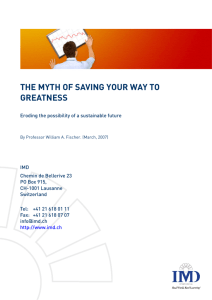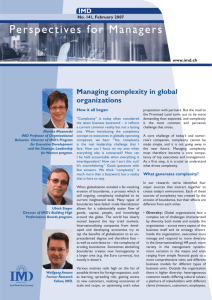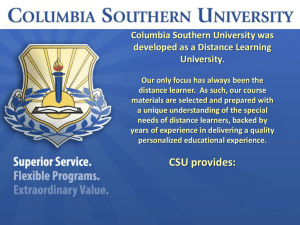Return to the Fundamentals
advertisement
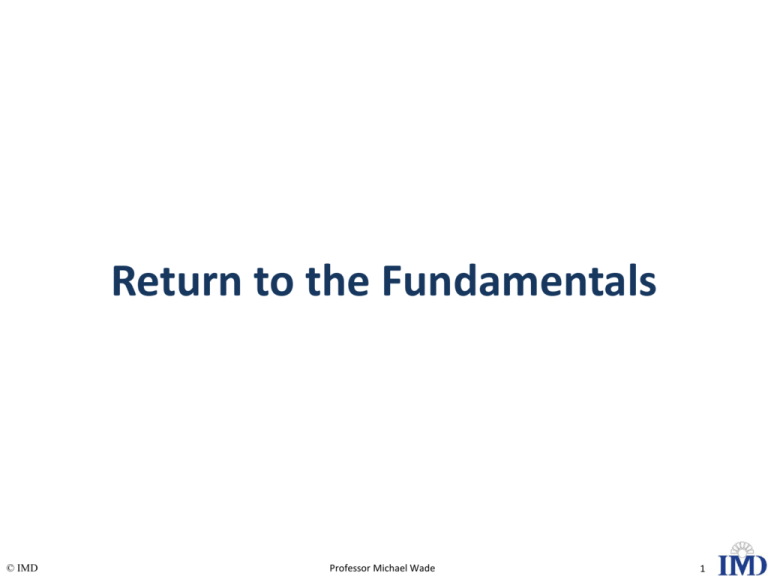
Return to the Fundamentals © IMD Professor Michael Wade 1 CUMULATIVE PROFITS 0 CUMULATIVE REVENUE © IMD Professor Michael Wade Adapted from Wilson and Perumal, 2010 2 CUMULATIVE PROFITS CUMULATIVE REVENUE © IMD Professor Michael Wade Adapted from Wilson and Perumal, 2010 3 © IMD Professor Michael Wade 4 Who is to blame for most of the complexity in our businesses? …WE ARE! WE CREATE OVERLY COMPLEX STRATEGIES… WE ADD MORE AND MORE PRODUCTS AND SERVICES… Too many things? # of SKUs 1970 Today 15 60 3 40 6 240 Blackberry vs iPhone © IMD Professor Michael Wade 8 What do you do in a mature market? Answer: Target narrower and narrower groups of customers by adding new products and services to your portfolio. But… Do people eat or drink more, wash their hair more, use their phones more frequently just because they have more products or services to choose from? © IMD Professor Michael Wade 9 More things, higher… • • • • • • • • • © IMD Set up times Training requirements Time to market Inventory Logistics Probability of defects Marketing costs Working capital Coordination costs Professor Michael Wade 10 WE ADD MORE AND MORE PROCESSES… …BUT DON’T RATIONALIZE OR STANDARDIZE THEM WE MEASURE AND REWARD LOTS OF THINGS… …BUT NOT COMPLEXITY WE BUILD CONVOLUTED ORGANIZATIONAL STRUCTURES… …UNTIL WE ARE NOT SURE WHO IS RESPONSIBE FOR WHAT The Complexity Curve CUMULATIVE PROFITS MANAGING GOOD COMPLEXITY REMOVING BAD COMPLEXITY 0 CUMULATIVE REVENUE © IMD Professor Michael Wade Adapted from Wilson and Perumal, 2010 14 How many LEGO Chefs do you need? How many people do you have developing new products versus rationalizing product assortments and eliminating old products? © IMD Professor Michael Wade 16 Which is simpler? 236 Planes, 9 types Three classes of service Revenue: £8B; Net income: (£425M) © IMD 189 Planes, 2 types (Airbus A319, 320) One class of service Revenue: £3.5B; Net income: £225M Professor Michael Wade 17 Complexity is caused by the number of things, the variety of things, and the interaction among things © IMD Professor Michael Wade 18 Here’s Another Curve % TOTAL PROFITS GOOD COMPLEXITY BAD COMPLEXITY 300% 200% 100% 0% © IMD 100% 50% % TOTAL PRODUCTS/CUSTOMERS/PROCESSES/ETC. Professor Michael Wade Adapted from Wilson and Perumal, 2010 19 © IMD Professor Michael Wade 20 Excuses you will hear “This product/service/process/customer is strategically important” “It’s a loss leader” “It defines who we are” or “It’s our core competence” “Customers will react negatively” “It’s early in the lifecycle. Profits will come.” “It’s all marketing/manufacturing’s fault” And the hidden one…”I may lose my job if you get rid of it” © IMD Professor Michael Wade Adapted from George and Wilson, 2010 21 Where are you? % TOTAL PROFITS 300% PERFORMERS: NEED TO AVOID THE ONSET OF BAD COMPLEXITY COMPLICATORS: NEED TO REVERSE THE SLIDE INTO BAD COMPLEXITY SIMPLETONS: NEED TO ADD MORE GOOD COMPLEXITY STRUGGLERS: NEED TO REDUCE BAD COMPLEXITY AND MANAGE GOOD COMPLEXITY 200% 100% 0% © IMD 100% 50% % TOTAL PRODUCTS/CUSTOMERS/PROCESSES/ETC. Professor Michael Wade Adapted from Simplicity Partnership, 2011 22 Steps to managing organizational complexity Step 1: Make it a priority! Step 2: Visibly push it from the top Step 3: Set up clear governance structure Step 4: Measure it (warning: your normal accounting will not work) – if you can’t measure it, you can’t manage it Step 5: Draw your complexity curve(s) and set goals Step 6: Action – cut out bad complexity IN CHUNKS – Cut unprofitable products/services, fire unprofitable customers, consolidate suppliers, eliminate duplicate and non-value adding process Step 7: Standardize remaining non-differentiating activities (the core) Step 8: Optimize differentiating activities (the edge) Step 9: Repeat steps 6-8 © IMD Professor Michael Wade 23 “Everything should be made as simple as possible, but not simpler” “We’re surrounded. That simplifies the problem.” General Lewis B. ‘Chesty’ Puller, U.S. Marine Corps, Battle of Chosin Reservoir, Korea Return to the Fundamentals © IMD Professor Michael Wade 25 Back up slides The Complexity Cube PRODUCTS/ SERVICES Where internal complexity comes From STRUCTURE PROCESSES Adapted from Wilson and Perumal, 2010 Vodafone ‘Simply Brilliant’ Program Strategy (how you compete) Structure Rewards (how you are organized) (How you incentivize) People Processes (Skills and capabilities) (how you do things) The STAR Model Vodafone ‘Simply Brilliant’ Program Strategy PROBLEM: Strategic direction not clear Conflicting agendas Company not profitable SOLUTION: 2 year strategic turnaround divided into 8 quarters All top 85 managers must define 5 priorities each quarter Each priority must be 6 words or less Performance self-rated after quarter (green, yellow, red) Strategies from all 85 managers fit on a single A3 sheet All strategies and results shared with top 400 managers BOTTOM LINE: Law of the jungle negotiation leads to strategic clarity Vodafone ‘Simply Brilliant’ Program Processes PROBLEM: 12,500 processes Huge amount of duplication, redundancy, and waste SOLUTION: Rigorous examination of all processes Duplicates and weak processes eliminated Where to start? 1. Surveyed customers and employees: What do you hate about us the most? 2. Asked: What would Amazon do? Cancelled all 400 senior management phone contracts Strong processes strengthened and made new standard Some new processes added (10%). BOTTOM LINE: Rigorous portfolio and process reduction, i.e. 32 SIMs to 3 Vodafone ‘Simply Brilliant’ Program Structure PROBLEM: Bureaucratic organization. Byzantine governance. SOLUTION: One weekend: Painted all walls white - no tribal symbols Another weekend: Removed all offices. Removed 30% of meeting rooms Installed some quiet areas, otherwise all open spaces No permanent desks – anything left on desks incinerated Removed bands of seniority Attractive severance packages offered Closed 15 buildings in Newbury, and 30 throughout UK 5,500 now in HQ, that before could fit only 3,200 BOTTOM LINE: Lower structural complexity changed corporate culture Vodafone ‘Simply Brilliant’ Program People PROBLEM: 12,000 people when CEO arrived – too many, but by how much? Tribal culture SOLUTION: Day 2, cut 2,000 people. Which 2,000? Doesn’t matter. Then cut another 1,000 people 6 months later Silos broken down – tribal signs removed headcount from 12,000 to 8,000 – feels about right BOTTOM LINE: Cut out people who don’t add value to customers Vodafone ‘Simply Brilliant’ Program Rewards PROBLEM: No clear incentive to change the status quo No incentive to manage or remove complexity Firefighter culture – come to us in a crisis Blame culture: at least the hole is not at my end SOLUTION: No rewards for ‘Dunkirk’ spirit Public rewards for preventing problems, eliminating complexity, and innovation 40-50 bottles of champagne (or Islamic equivalent) / mo Rule: Thou shall not miss thy child’s sports day Flexible office time (but available all the time) Local hotels came to complain BOTTOM LINE: Reward behaviour that promotes good complexity

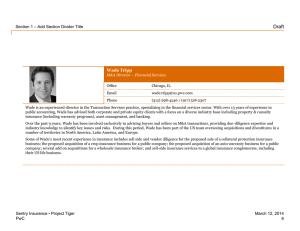
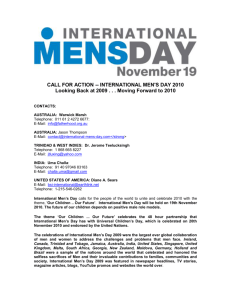
![Arrival of Wade Keiffer[1]](http://s3.studylib.net/store/data/008164778_1-51788b3e4d580af943e609fb94f63938-300x300.png)
